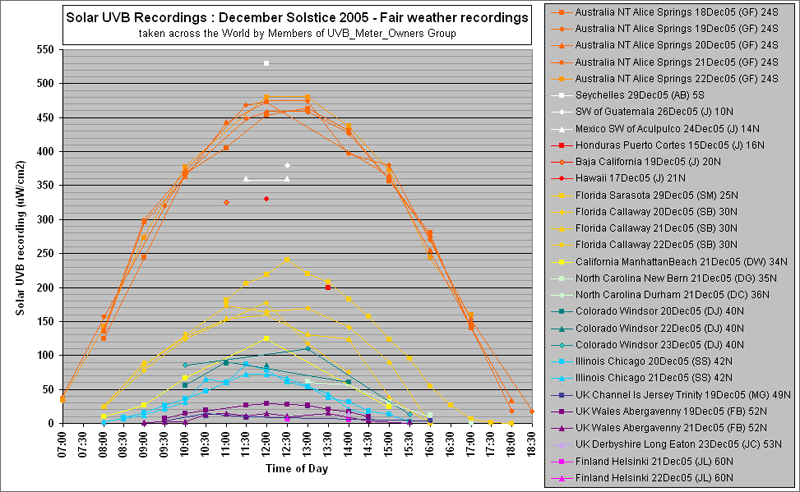kingofnobbys
BD.org Sicko

from http://www.uvguide.co.uk/uvinnature.htm
Note the UVB flux for Alice Springs which is considered prime central bearded dragon native habitat.
Data for Alice Springs
Location 23°42′0″S 133°52′12″E.
Alice Springs is just South of the Tropic of Capricorn the town of Alice Springs straddles the usually dry Todd River (which rarely has flowing water in it) on the northern side of the MacDonnell Ranges. Alice Springs is located in Central Australia, also called the Red Centre, an arid environment.
In Alice Springs, in summer, the average maximum temperature is in the mid 30s (Celsius), whereas in winter the average minimum temperature can be 5.5 °C (41.9 °F), with an average of 12.4 nights below freezing every year.
The elevation of the town is about 545 metres (1,791 feet), which contributes to the cold nights in winter.
The annual average rainfall is 285.9 millimetres (11.3 in) which would make it a semi-arid climate except that its high evapotranspiration, or its aridity. Dry tropical woodland savannah.
Discussion of above graph
It can be seen that during most of the day in their natural range the microW UVB /sqcm is higher than 300. Peaking at just under 500 microW UVB / sqcm .
I've lived in CBD territory and seen them out ( hunting, foraging , basking) right through the day except on the very hottest days (can reach between 46 - 50oC there).
There are no commercial UV tubes or globes available designed for reptiles which will produce the levels of UVB beardies encounter in their natural range in summer , the UVB source would have to sitting right on the beardie's head or back to reach UVB fluxes higher than 300 microW / sqcm.
It's unlikely to that you can mount your UVB source (compact, T8 or even T5HO) too close.
And an MVB will literally cook the beardie before you get close enough to have even 300 microW UVB / sqcm.
IMO if you try to get about 180 - 200 microW UVB / sqcm at the basking spot you will be doing OK, I call this distance required from the tube or globe to the basking spot that achieves this UVB flux the OPTIMAL DISTANCE . (The OPTIMAL DISTANCE will be a lot closer than the EFFECTIVE DISTANCE.)
A good guide is shown below :


Here is some data for an 80W MVB from Arcadia.

The optimal distance shown here between the lines is determined by temperature. UVI readings you will note they are quite low for this globe's operating distance for a beardie's optimal basking temperature range..Hence the need to have a secondary UVA and UVB source (either a compact , or a T8 , or a T5HO tube positioned at the OPTIMAL DISTANCE for this UVB source).
ie if you are already getting 40-43 degCelsius at the basking spot with your current MVB, going up to a higher wattage MVB will not help (as you will simply make the basking spot too hot and beardie wont voluntarily go there) even if you manage to get the UVB to about the required level of 180 - 200 microW UVB / sqcm at the basking spot . So it proves counter productive with a single all in one heat+light+UVA+UVB source.

